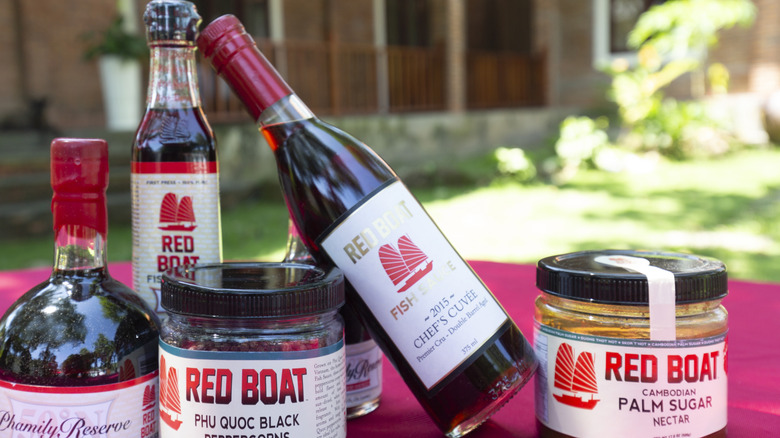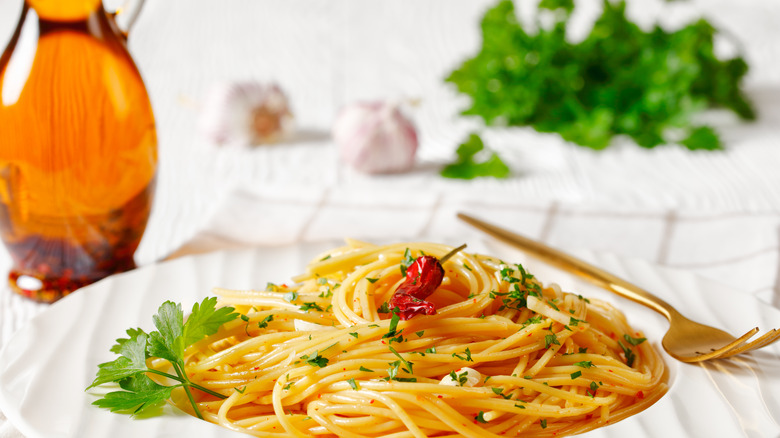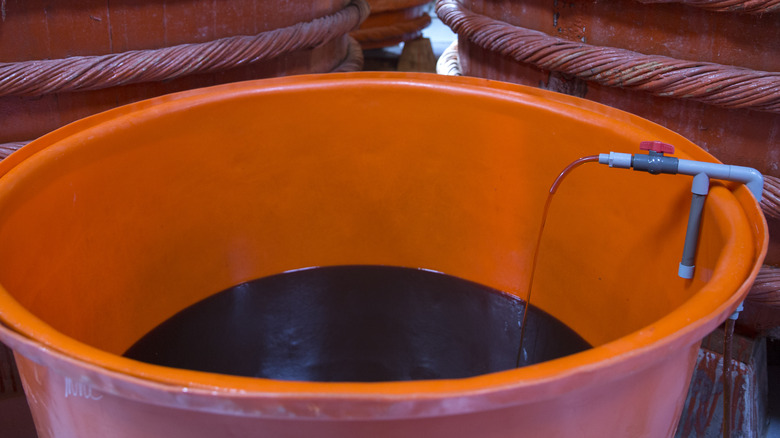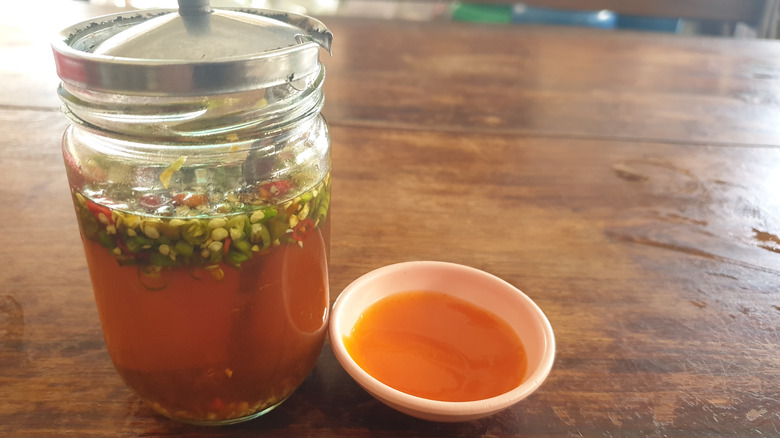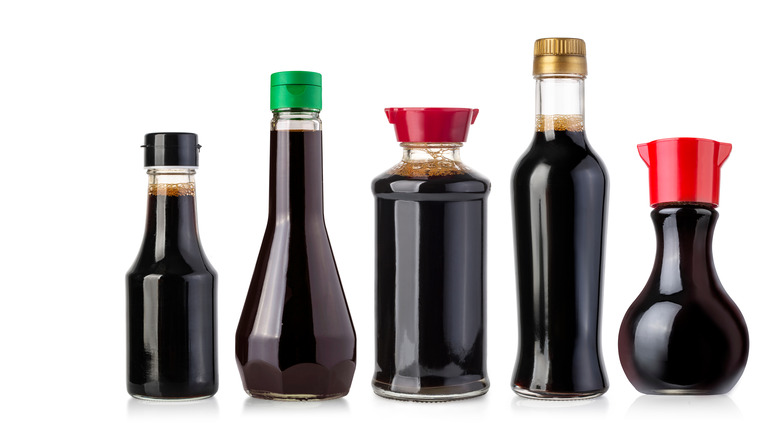What Is Fish Sauce And How Do You Use It?
Soy sauce may be the king of condiments where Asian cooking is concerned, but we wouldn't be surprised to call fish sauce the region's queen (via The Woks of Life). Whether it is called teuk trei in Cambodia, patis in the Philippines, nam pla in Thailand, and nuoc nam in Vietnam, no self-respecting kitchen in South East Asia would be without fish sauce, which imparts umami to most of the dishes unique to the region (via The Spruce Eats).
While fish sauce might be found at any supermarket, Martha Stewart suggests picking up your bottle at an Asian grocer, which may have a greater selection of fish sauces from different countries on offer. Because fish sauce keeps for a while, it may be best to purchase a smaller bottle, and to keep that in a dark, cool place in your pantry. Martha Stewart also suggests keeping fish sauce away from areas where there might be extreme temperatures, like near a hot stove, or in the refrigerator to keep it from getting spoiled.
What is the history of fish sauce?
Fish sauce may be synonymous with Asian cooking today, but according to some food historians, the ingredient stays true to the ancient maxim: "all roads lead to Rome." The Asian condiment could have descended from a type of sauce called garum, which is mentioned in literature that dates back to the 3rd and 4th century BC (via NPR). Like its Asian descendants, garum was made by creating alternating layers of fish and salt until the entire mixture fermented. Once done, it would be used as a substitute for salt, and as the fundamental ingredient for dips and sauces. It was so prized, archaeologist Claudio Giardino told NPR, that buying a bottle could cost households the equivalent of $500 in today's currency.
There was one difference in the way ancient Romans did their garum, and the way Asian fish sauce makers make their condiment today. Speaking with NPR, food historian Sally Grainger says the Romans used far less salt, comprising just 15% of their fish sauce. Regardless, salt was still a key ingredient, so when it got too expensive, people just stopped making it. But garum doesn't just live on in today's Asian fish sauces, it is also embodied in colatura di alici, which Serious Eats describes as the modern Italian equivalent of fish sauce and a "relative" of garum.
How is fish sauce made?
Fish sauces are usually made with two ingredients: fish and salt; but the quality of a fish sauce rests on the kind of fish a manufacturer buys. The Kitchn's Lisa Pepin, who visited a fish sauce factory in Vietnam (so we wouldn't have to), says the best sauce is made with just one kind of fish, although manufacturers can mix fish in order to cut costs. The Spruce Eats notes the most common fishes used are anchovy, krill or mackerel.
Approximately 10,000 kilograms (22,000 pounds) of fish and 15 kg (33 lbs of salt) are mixed and left to ferment in huge vats; this fishy slush is stirred everyday to help it break down in a process that takes about six months. A half a year of patience will yield a fish puree where the solids are at the bottom of the vat and the liquid would have risen to the top. This puree is then strained so that the liquid becomes fish sauce, and the solids become livestock feed, The Kitchn explains.
The liquid is then exposed to the sun for up to four weeks so water can evaporate, leaving a concentrate. This liquid is then moved into an urn or barrel to age further, because the longer it sits, the sweeter it becomes. All told, good fish sauce can take between nine months to a year to make.
How is fish sauce used?
While salt and pepper reign supreme on the tables of Western restaurants around the world, you're more likely to see fish sauce offered as a lead condiment at South East Asian restaurants. Fish sauce may taste both fishy and salty on its own, but when mixed with other ingredients such as lime juice, sugar, garlic, and chili it lends an umami quality to dishes, whether your stir it into Thailand's signature stir fried pad Thai noodles as a condiment, make it part of a dipping sauce for Vietnamese-style spring rolls and pork chops, or turn it into a marinade for Filipino adobo (via Kawaling Pinoy). If you're looking to add a bit of umami to your dishes, fish sauce is a solid choice.
A tablespoon of fish sauce only carries 10 calories, of which 2 grams comes from carbs and 8 grams comes from protein. It's also fat free, making it a great condiment to use when you're watching your weight. But you'd still need to be careful when using fish sauce — given that salt is a primary ingredient, you'll need to know that a tablespoon can hold an eyewatering 1400mg of sodium, or about 60% of your recommended daily allowance.
What are the substitutes for fish sauce?
Fish sauce isn't for everyone — you might have an allergy to one of its ingredients or you might be a committed vegetarian. If you find yourself needing fish sauce in a recipe or to make as a dipping sauce, there are other things you can use as substitutes. The Stone Soup recommends using dark soy sauce either neat, spiked with a bit lime juice for a tang, or with rice vinegar in a one to one ratio. If you happen to have anchovy at home, Healthline says you might consider mixing anchovy and soy; or if you're looking for a standalone ingredient, you could consider tamari, oyster sauce, coconut aminos, worcestershire sauce, as well as mushroom and soy broth.
If you need to pass on fish sauce on account of dietary restrictions, there are ways to replicate its flavor, if not to a T. Gourmet Sleuth offers the option of making a vegetarian version using Chinese fermented black soybeans, soy sauce, sherry, and miso.
